So, which brands are succeeding on social? Here’s a run-down of how brands are utilising various platforms and why their strategies are working.
Booking.com and YouTube
According to research, 50% of travellers use online video before they book a holiday, largely for decision-making purposes on where to go, as well as researching accommodation and activities. Due to this, it can be incredibly helpful for brands to think like a publisher rather than an advertiser. In other words, to create informative content (such as destination guides) to help viewers make an informed decision during a moment of need.
Booking.com does this particularly well on YouTube, creating a series of local travel guides about popular places such as Lisbon, Barcelona, and Amsterdam.
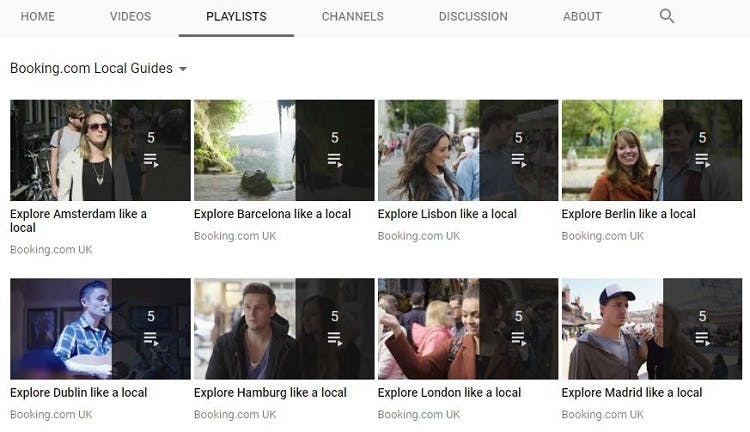
More recently, it’s taken a more inspirational tack, with a campaign based around the travel stories of its 14,000 employees in 2016. The main video, ‘One Mission’, effectively builds a chronological portrayal of travel, starting from arrival at the airport and all the way to touch-down home. A great example of video storytelling.
Soho House and Instagram
When you think of travel brands, you tend to think of online travel agencies or airlines. However, hotel and hospitality brands also come under this umbrella – and they are becoming particularly adept at using social to increase awareness and extend reach.
Instagram is arguably the ideal channel for hotels, especially luxury ones. With its visual and curated nature, the platform allows brands to showcase the very best of what they have to offer, tantalising guests with beautiful design and luxurious customer service.
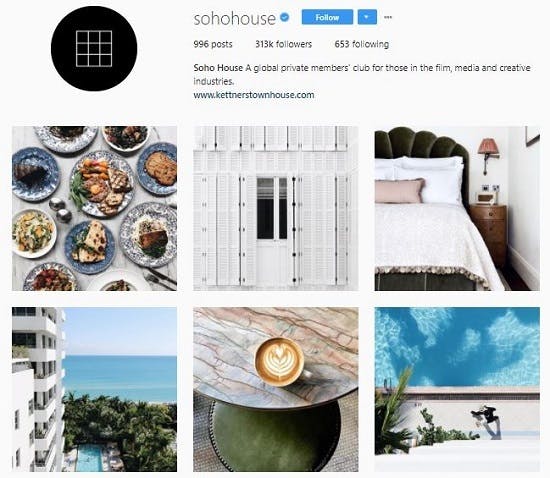
With 313,000 followers, Soho House has built an impressive following on its Instagram channel, which is populated with stunning (and unashamedly cliché) lifestyle imagery.
From flat whites to furnishings, it cleverly shines a light on elements of its hotels around the world – and undoubtedly instils the desire to visit.
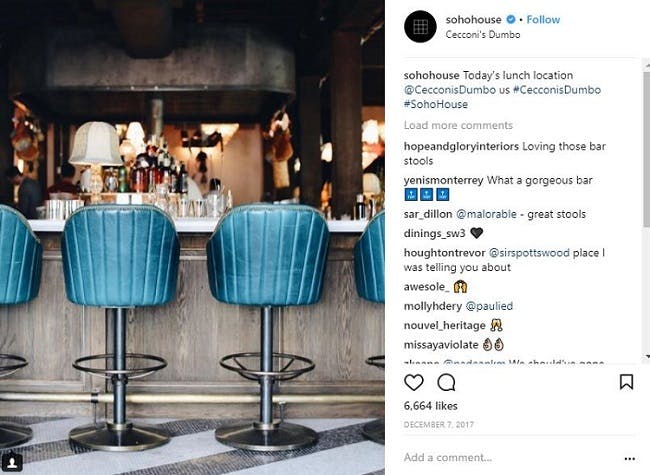
Lonely Planet and Pinterest
While people on Instagram might prefer to simply marvel at travel imagery, Pinterest users are reportedly more proactive, with an average of 2m travel-related saves taking place on the platform each day. This means that users are saving ideas in order to help make informed decisions, building and curating their own travel boards (i.e. ‘solo travel’ or ‘family destinations’).
Despite this, there aren’t many brands that take the opportunity to create bespoke content for the platform. One that does is Lonely Planet, having built up a wide selection of boards. From ‘Wellness and Travel’ to ‘Tastes of Thailand’, it aims to engage users based on specific interests.
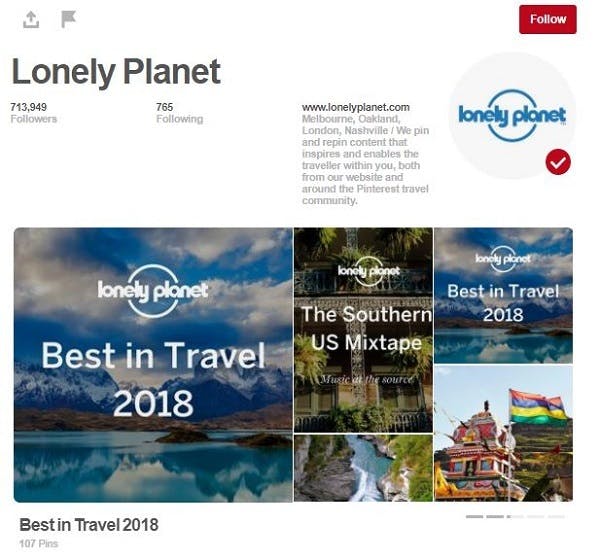
Lonely Planet also incorporates content from third-party sites and bloggers in its Pinterest boards, which help to create a sense of community. It even accepts contributions from the public, meaning that its audience is likely to feel involved and more connected to the brand.

KLM and LinkedIn
According to a survey by MRI, LinkedIn users aged 18 to 44 are over twice as likely to join flight and hotel reward schemes compared to users of other social networks. What’s more, they’re also twice as likely to travel internationally and are more likely to show loyalty toward brands.
This might come as a surprise to many, but some travel brands have been keen to capitalise on LinkedIn’s power for a while now. Back in 2014, KLM airlines was one of the first brands to offer a 24/7 service via LinkedIn, allowing users to contact the brand via the social platform.
Since, it has continued to harness the platform’s shift into a publishing network rather than just a professional one, using it to distribute brand content. It publishes blogs and articles on a regular basis, aiming to push LinkedIn’s large user-base towards it website, as well as position itself as an expert voice on the aviation industry.
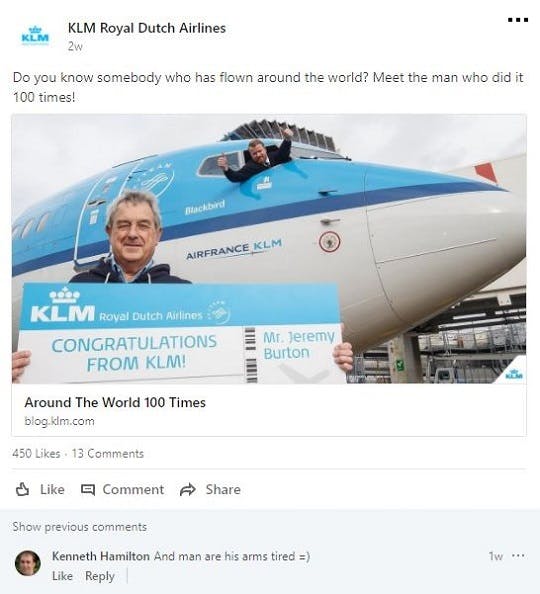
Delta Airlines and Twitter
Twitter is often used by travel brands as a customer service channel, with companies reportedly seeing a marked increase in customer satisfaction on the back of timely and relevant responses.
However, Twitter can also be used as an effective tool for branding – particularly when it comes to competition between companies.
Delta Airlines is one airline that has displayed both strategies in the past, using its Twitter account to provide customer support, as well as the occasional bit of shade when necessary. For example, when a United Airlines passenger was refused to board a plane because she was wearing leggings, Delta fired back with a cheeky retort.
Flying Delta means comfort. (That means you can wear your leggings. )
— Delta (@Delta) March 27, 2017
Similarly, when American conservative commentator Ann Coulter launched a tirade against Delta last year, the airline responded with what was described as a ‘bold and strategic’ approach. As a result, many applauded the airline’s defence of its own values, and supported its decision to call out Coulter.
@AnnCoulter Additionally, your insults about our other customers and employees are unacceptable and unnecessary.
— Delta (@Delta) July 16, 2017
While using Twitter in this manner can be a potentially dangerous strategy, Delta shows that if a brand’s tone is consistent and in line with its wider character and values, it can be a way of enhancing exposure and building positive sentiment.
Aer Lingus and Snapchat
Snapchat is not the most obvious channel for travel brands. Surely the picture-perfect world of Instagram is where it’s at? Perhaps when it comes to destination marketing, yes, but for brands wanting to give more of an insight into their company culture or a sneak peek at behind-the-scenes – Snapchat Stories can be hugely effective. What’s more, it’s also ideal for targeting the platform’s young and highly-engaged user-base.
Aer Lingus is one brand that uses Snapchat in this way, posting content about what it’s like to work for the company. Its Stories often provide insight into flights and company events.
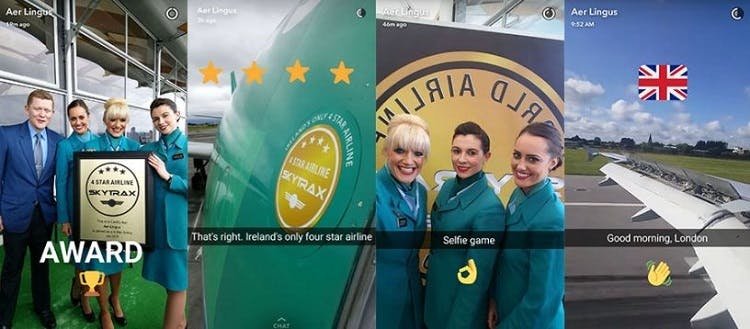
(Image via Social Talent)
It also uses the platform to announce new routes, such as the example below which is in celebration of the new Aer Lingus route into LA. All in all, it gives a refreshing and unique insight into its brand, which could help to inspire future careers as well as travel.
Related reading:

Comments